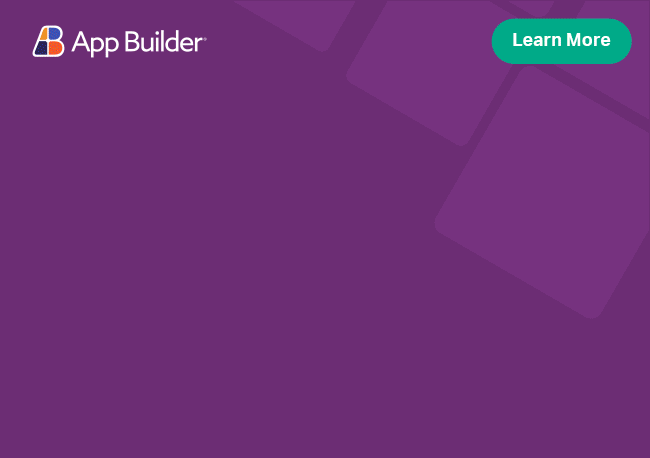
App Builder June Release: Conditional Data Actions, Grid Master-Detail, Spanish Localization & More
The June update of App Builder brings a fresh wave of productivity features aimed at accelerating app development and streamlining user interactions. With Conditional Data Actions, you can now build smarter logic into your workflows based on the success or failure of API calls—no code required. The new Grid Master-Detail Template lets you visually enrich […]
The June update of App Builder brings a fresh wave of productivity features aimed at accelerating app development and streamlining user interactions. With Conditional Data Actions, you can now build smarter logic into your workflows based on the success or failure of API calls—no code required. The new Grid Master-Detail Template lets you visually enrich row data with expandable, context-aware views. And for global teams, we’re introducing Spanish localization across the platform. Combined with design-time enhancements and expanded UI variants like Outlined and Contained Icon Buttons, this release puts more design power and logic control at your fingertips.

Before diving into these new functionalities, if this is your first time learning about App Builder, let me quickly share why you should consider it a key tool in the application development process for your organization:
- A visual app builder – the unified platform for C-level executives, enterprise architects, dev team leaders, designers, developers, and stakeholders.
- Cloud-based WYSIWYG drag & drop tool that helps companies design and build complete business apps 80% faster than ever.
- A low-code tool generates production-ready code for Angular, React, Web Components, and Blazor, and converts Figma designs to code.
What’s new in this App Builder release?
Enhance Your Grid with Master-Detail Templates
Master-detail templates in App Builder bring powerful interactivity to your data grids. By enabling expandable rows, you can let users reveal more details tied to each record—like a customer’s recent orders, an employee’s performance, or a vehicle’s trip history—right inside the grid.
With App Builder’s intuitive design-time support, you can drag and drop components like cards or text blocks into the expanded detail area and bind them to the current row’s data context. It’s a fast and flexible way to build informative UIs that go beyond flat tables.
To use it, just enable the Grid-details option from the Properties panel, add your components, and bind them to the row data.
Let’s look at the following demo ⬇️

The demo above showcases a Master-Detail layout in action, applied within a CRM application. It demonstrates how selecting a customer reveals their associated orders, and further—how each order dynamically loads its related order details.
In this setup:
- The main View displays a list of customers and upon selecting a customer, you can see their orders.
- A secondary Order Details Grid has been added, which is bound to the row context of the selected order.
- This context-driven binding ensures that when a user selects a specific order, the Order Details Grid updates to show only the relevant information.
This demonstrates how easily you can build a drill-down experience using contextual data binding, allowing users to explore hierarchical data relationships—without manual wiring or extra code.
Preview everything live and export your app with the generated code. Keep in mind that certain advanced bindings—like per-row parameterized data sources or overlay components like Dialogs—aren’t currently supported in code generation. Have a look at the full help topic here.
Smarter Workflows with Conditional Data Actions
With this release, App Builder introduces Conditional Data Actions—a powerful way to control app behavior based on the outcome of a data request. You can now define follow-up actions that trigger only if the initial action succeeds or fails. For example, show a success banner after a successful form submission or prompt an error message if it fails.

This feature keeps things clean and focused: conditions are currently limited to data actions only, and support a simple pass/fail evaluation without needing to check specific HTTP codes. You can also use variables within conditions and benefit from contextual dropdowns that help clarify whether you’re referencing an input, a result, or a user-defined variable. It’s a foundational step toward more intelligent and responsive app logic—no coding required.
The demo below showcases the output of Conditional Actions in action within an HR Dashboard application. It demonstrates how you can enhance your app’s flow by dynamically handling the process of adding a new employee and offering contextual navigation based on the result.
Here’s what happens:
- When a new row is added to the Employee Grid, a Conditional Action triggers a PUT request to the backend.
- If the request succeeds, two things happen:
- A variable is set to store the newly created employee object.
- A snackbar notification appears, confirming the success and offering a navigation button to a detailed Form View pre-filled with the new employee’s data.
- If the request fails, a dialog window is displayed to notify the user of the issue.
- After editing the employee in the Form View and submitting updates, a second snackbar appears, guiding the user to the Team View, where they can see the full list of employees—now including the newly added or updated one.
This flow highlights how Conditional Actions can orchestrate a seamless, multi-step UX – from data creation to easy in-app navigation – without writing a single line of code.

¡Hola! App Builder Now Supports Spanish
App Builder now offers Spanish localization, making it easier for Spanish-speaking users to navigate the design surface, toolbox, property panels, and more. This update ensures a more accessible and inclusive experience by automatically adapting the interface based on your browser language settings or preferences.
New Icon Button Variants: Contained & Outlined
App Builder now supports Contained and Outlined variants for the Icon Button component, aligning it with the options available in our design systems and Figma UI kits. These new styles give you greater flexibility in matching your app’s visual tone, whether you’re going for a bold, filled look or a minimalist outline. The update provides full support across the platform, including design-time configuration in the App Builder UI, accurate code generation with updated component definitions, and seamless import from Figma to maintain a consistent design-to-code flow.
Wrapping Up
May’s release reflects our ongoing commitment to delivering scalable, modern app experiences in App Builder. Whether you’re designing complex data grids, enforcing robust validation rules, or streamlining DevOps workflows, this update gives you the tools to move faster and build better.
Try the new features today at appbuilder.dev
App Builder is a game-changer in the app development process. With its cloud-based visual builder, low-code capabilities, and new features, it’s a must-have tool for any organization. Try it out today! If you need more details, we encourage you to check out our:
To experience everything in the latest App Builder updates, visit your customer portal and get the latest version. As usual, we are always excited to get your feedback and hear what you want to add or recommend. So please email me at zkolev@appbuilder.dev and let me know how we can help you continue delivering value to your customers with Infragistics.


